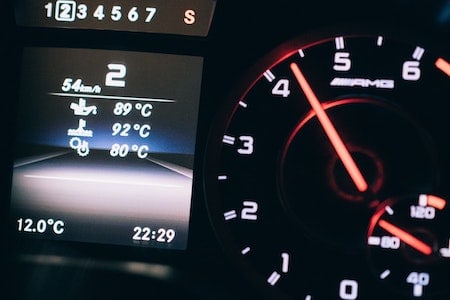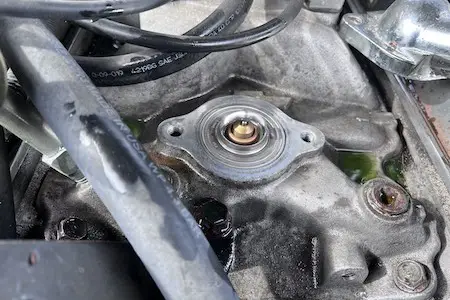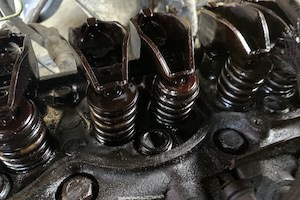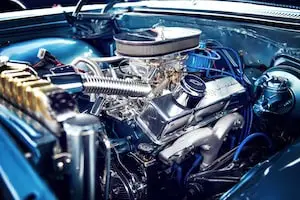Your car runs in a very fine temperature range to provide optimal performance. A close watch on fluid levels is a must because just one minute without the proper fluid and cooling systems in place, and your car can overheat! An overheated engine can result in permanent damage and must be avoided. So how do I know how to deal with such a complicated system? And what should the proper temperature of my engine be?
This answer can be complicated but is broken down very simply in this article. I will cover the average temperatures of a car engine for both gasoline and diesel internal combustion engines and then cover some of the other questions you may have if you are concerned about the temperature of your car.
What is the normal operating temperature for a car engine?
Normal operating temperature for a gasoline car engine is between 195 and 220 degrees Fahrenheit. Diesel engines operate at a slightly lower temperature between 180 to 210 degrees Fahrenheit. At these temperatures the engine is most efficient and should be within this range in normal conditions.

Normal Operating Temperature
Normal operating temperature for a gasoline engine is between 195 and 220 degrees Fahrenheit.
These are the “normal operating temperature ranges” meaning the car will operate normally without any damage being done. It is possible for the engines to run outside of this range. Below the normal operating temperature range, it may be difficult for the car to start, and the engine my run with poor fuel mileage.
Normal operating temperature also IN GENERAL. This is normal for internal combustion engines in a car. Other combustion engines often do not run as hot that are air cooled such as engines in lawn mowers and some motorcycles.
There are certain things that you can do to restore your car to factory capability of being able to regulate the engine temperatures.
Why do cars operate at their specific temperatures?
Car engines are designed to run within these temperature ranges for optimal efficiency.
Water, with some additives, circulate throughout the engine (without mixing with the engine oil) and cools the engine. The water is cooled through the radiator, and fans are set to turn on as needed.
The engine produces heat as a byproduct of the continuous combustion reaction of fuel and air in the cylinders. By maintaining the engine at the right temperature, less of the energy from the combustion reaction will go into the heating of the surroundings and more of the energy is transferred to work on the system. Meaning turning the wheels!
How does an engine regulate the operating temperature
Car engines are most often water cooled engines. Water cooled means that cool water passes through passages in the engine block to lower the temperature of the engine. The water is cooled by passing through the radiator that cools the water with the passing of cool air from outside the vehicle.
A radiator fan is used to draw more air through the radiator and generally turns on automatically when it is needed.
Above the normal operating range and the engine begins to enter the range of running hot.
An engine may run hot and is expected to when:
- The engine is under heavy load – pulling a heavy trailer etc.
- Hotter exterior conditions – driving through the desert
- Less air flow – driving in traffic
Hot Engine Temperature
At what temperature is a car considered Overheated?
Above a coolant temperature of 240 degrees Fahrenheit is too hot. The overheating problem should be resolved right away and action taken to bring the engine temperature down.
Less time moving reduces the amount of air able to pass through the radiator
being under heavy strain and the limits the engine can handle without damage are both at at this temperature to optimize efficiency with the least amount of energy lost to heat as possible.
Do I need a temperature gauge in my car?
A temperature gauge is not really needed in your car. Most cars have a temperature light that does a better job at alerting the driver if the engine is overheating. The gauge does the same thing but not as well. If you would like a temperature gauge just to monitor the temperature at which your engine is operating that can be added and you should check out my other article on installing a mechanical temperature gauge.
Maybe your car does not have a temperature gauge. My current car does not have one although I have had cars in the past with a needle temperature gauge and it was a helpful feature when working the car extra hard to know exactly what the temperature was doing.
A temperature gauge is not needed and most new cars do not have one. They are more common with heavy duty trucks and it is a good idea to have a temperature gauge when the vehicle is put under heavy strain or has to run for long under high stresses.
How do I know if my engine is warmed up if I don’t have a temperature gauge?
You don’t normally have to wait until your car is warmed up. Give it a few seconds, and go! If you would like to read more on this debated topic, I wrote an article covering 13 Most Misunderstood Things About Car Engines. One of the points addresses the concern of allowing the engine to warm up.
Some vehicles like new Mazda models have an engine coolant temperature gauge. It will provide you with an indication that the engine has reached operating temperature with a blue warning light or something similar that will go off once the car has reached normal operating temperature.
What Do I Do If My Car Overheats
If your car is overheating, pull over and shut off the car. Wait at least 20 minutes to let your engine cool down. Check the radiator fluid immediately after the engine has cooled off. It is often a far better decision to have your car towed and inspected rather than continuing to drive it hoping it stays cool. Also pull over and let your car take a break if the overheating is occurring while pulling a load such as a trailer.
Overheating while pulling a trailer means that you are overstraining the engine and risk permanent damage. Better find a bigger truck for such a big load next time. And of course inspect things on your truck if it is already big enough.
Especially if you are uncertain about the amount of coolant in the radiator! If you are unsure, shut the car off.
If you are certain there is plenty of coolant, and plenty of clean oil in the engine, here are three more ideas of things you can do to help your car cool down:
- If you are close to a hose, pour water on the radiator. Water on the radiator will significantly cool down the water that is circulating through the engine. This is helpful only with the car still running so keep it running in this case.
- Coast to allow cool air to flow past the radiator. If you are headed downhill and have the ability to coast, this is better than sitting on the side of the road because of the cooling effect of the air.
- Turn on the heater. Not the AC! You should not turn on the AC to cool down your car because the air conditioning compressor is run by the engine and by turning on the compressor, you are making the engine work harder! On the other hand, by turning on the heater, you are blowing air over the heater core which is filled with hot coolant from the engine. This has a slight cooling effect on the engine coolant.
Causes of an overheating car
An overheating car can be caused by a faulty thermostat, a plugged radiator, dirty oil or coolant, or too much load on the engine.
Faulty Thermostat
The thermostat in a car acts as a gate allowing coolant to circulate through the engine at a certain temperature. The thermostat generally opens at 190 degrees Fahrenheit.
A thermostat is needed in a car to prevent coolant from circulating through the engine until a certain temperature is reached. This allows the engine to warm up more quickly and quickly get to operating temperature which is the optimal temperature that the engine will run most efficiently.

Plugged Radiator
A plugged radiator will restrict the flow of coolant
You can check if the coolant in your radiator is circulating by squeezing the radiator hose while the car is running and someone else revs the engine. If the pump is circulating coolant, the radiator hose will swell when the car is revved. Otherwise it could be an indicator that the radiator is plugged or restricted.
Not adding distilled water to the radiator is the most common reason for a radiator to get plugged. When adding antifreeze, you must also add distilled water to dilute the antifreeze to 50/50. Not adding distilled water will cause mineral deposits to be left inside the radiator and plug the little passage ways over time.
This can be fixed with a simple radiator flush!
Dirty Oil or Coolant
Change your engine oil! It is the most important bit of maintenance that you can do to your car and if the age of the oil is in question, change it. I always change it when it begins to look dark.
Dirty oil is contaminated with carbon, pieces of metal, and burned fuel. When it is contaminated with these things it loses it’s ability to cool as effectively.
Heavy Engine Load
Perhaps you are pulling a boat, or a moving trailer. Or even a full car of people and belongings can do it. If you can notice the difference while you are driving then certainly your engine feels it. And isn’t happy. Drive more conservatively with a full load, and next time use a bigger truck or take a smaller load.


